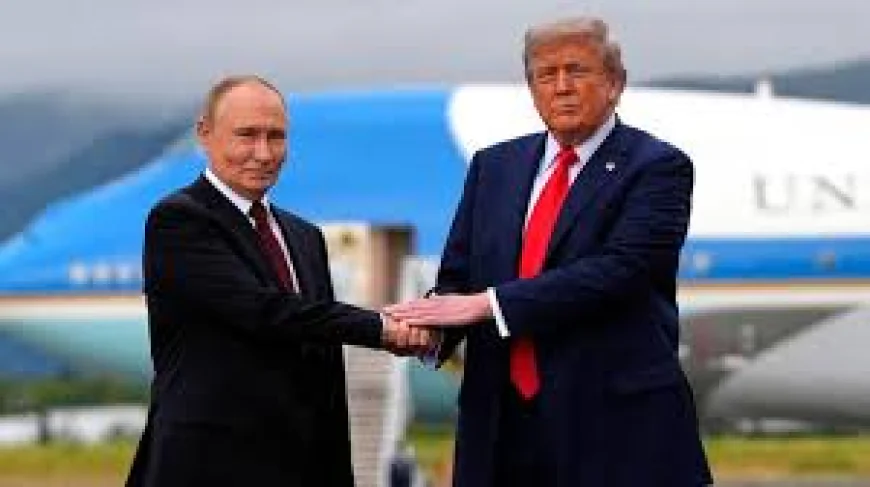Ceasefire Hopes Fade After Trump–Putin Meeting Yields No Agreement
The August 15, 2025 summit between U.S. President Donald Trump and Russian President Vladimir Putin, held at a military base in Alaska, concluded without any signed agreement or ceasefire on the Russia–Ukraine war. Despite formal greetings and ceremonial optics, the key outcome was Russia’s proposal for Ukraine to cede territory in exchange for a ceasefire; a plan swiftly rejected by Ukrainian President Volodymyr Zelenskyy. Putin claimed an “understanding” had been reached, while Trump admitted no deal was made. The summit sparked widespread criticism, with many analysts saying the meeting gave Putin diplomatic leverage without delivering results for the U.S. or its allies. European leaders issued a unified statement supporting peace talks but rejecting any forced concessions from Ukraine. The meeting is widely regarded as a missed opportunity and a strategic win for Russia diplomatically.

Trump–Putin Alaska Summit Ends Without Breakthrough Amid Rising Global Tension
Anchorage, Alaska — The highly anticipated summit between U.S. President Donald Trump and Russian President Vladimir Putin on Friday, August 15, 2025, concluded with no formal agreement, despite ceremonial grandeur and initial optimism. The meeting, held at Joint Base Elmendorf–Richardson in Anchorage, marked Putin’s first visit to U.S. soil in nearly two decades and came at a crucial time in global diplomacy.
A Symbolic Yet Strained Atmosphere
Both leaders arrived to a red carpet reception, military salute, and a brief motorcade ride together in President Trump’s official limousine. The display of cordiality raised hopes of a diplomatic breakthrough, particularly concerning the ongoing Russia-Ukraine war.
However, the summit’s outward pageantry quickly gave way to stalemate. In a brief joint press announcement, President Trump stated that no ceasefire or formal peace deal had been reached, while Putin vaguely referenced an “understanding” between the two nations, leaving observers confused and unsettled.
Conflicting Narratives Over Peace Talks
According to reports confirmed by Reuters and AP News, Putin presented a proposal to freeze current battle lines in Ukraine in exchange for Ukrainian withdrawal from key territories including Donetsk, parts of Kherson, and Zaporizhzhia. President Trump relayed this proposal to Ukrainian President Volodymyr Zelenskyy, who outright rejected it as unacceptable.
While Trump claimed he was trying to “find a fair path to peace,” critics argue that the proposal favored Russian territorial gains and compromised Ukrainian sovereignty. Analysts have widely concluded that Russia walked away from Alaska with a stronger diplomatic stance.
European Leaders Respond
Following the summit, European Union leaders issued a joint statement:
-
Welcoming peace efforts in principle
-
Emphasizing that any negotiations must include Ukraine directly
-
Rejecting forced territorial concessions
-
Reaffirming sanctions on Russia until a fair resolution is reached
The statement reflected cautious diplomacy; supporting peace but signaling clear disapproval of any deal that undermines Ukraine’s sovereignty, or independence.
Critics Call the Summit a Missed Opportunity
The summit drew fierce public commentary worldwide. Tennis legend Martina Navratilova criticized Trump’s posture during the post-meeting press moment, calling it the “body language of a beaten man.” Author Stephen King described the summit on X (formerly Twitter) in six sharp words: “Putin took Trump for a fool.”
American and European media outlets widely reported that Putin appeared more assertive and strategically prepared. Commentators argue that Trump failed to secure lasting diplomatic concessions or improvements on issues such as election interference, nuclear agreements, or military de-escalation.
Historical Significance
This meeting was symbolic in multiple ways:
-
The first Russia-U.S. summit on American soil since 2007.
-
Hosting Putin on a U.S. military base was unprecedented and controversial.
-
Alaska was specifically chosen because it lies outside the reach of the International Criminal Court, which has issued an arrest warrant for Putin in relation to alleged war crimes in Ukraine.
The setting also highlighted Alaska’s historical connection to Russia, adding an additional layer of geopolitical symbolism.
Key Takeaways at a Glance
-
Date & Location: August 15, 2025 — Joint Base Elmendorf–Richardson, Anchorage, Alaska
-
Outcome: No signed agreement, no ceasefire, conflicting public statements
-
Russia’s Position: Demands Ukrainian withdrawal from multiple contested regions
-
Ukraine’s Response: Rejected proposal as unacceptable
-
Europe’s Stance: Support for peace talks, but firm on Ukraine’s sovereignty
-
Public Reaction: Heavy criticism, concerns over U.S. diplomacy and Putin’s advantage
Conclusion
The Trump–Putin Alaska summit ended with more questions than answers. While the leaders portrayed a cordial front, the meeting produced no substantial policy shift or path forward on Ukraine. Critics suggest that the summit may have unintentionally strengthened Russia’s diplomatic leverage while leaving the United States and its allies scrambling to reaffirm collective positions.
As geopolitical tensions persist, global attention now shifts to whether future negotiations will include Ukraine more directly, and whether President Trump will push for a revised framework that both sides can accept.
Source:
AP News/Reuters/CNN


